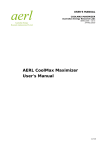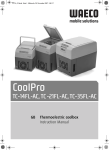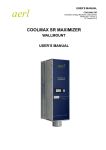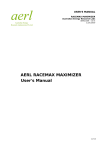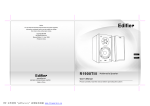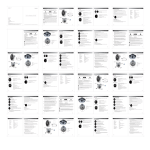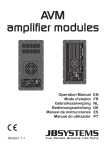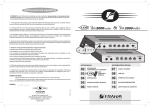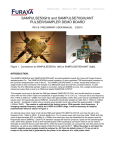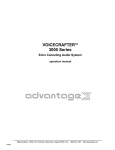Download AERL CoolPro CP User's Manual
Transcript
USER'S MANUAL COOLPRO CP Australian Energy Research Labs AER04.002 – ver 1 16 November 2010 AERL CoolPro CP User's Manual 1 of 14 USER'S MANUAL COOLPRO CP Australian Energy Research Labs AER04.002 – ver 1 16 November 2010 TABLE OF CONTENTS 1 Overview........................................................................................................................3 2 Cathodic Protection Background.....................................................................................4 2.1 Ground Bed Resistance............................................................................................................................4 2.2 Corrosion Potential...................................................................................................................................4 2.3 Reference Cell measurement...................................................................................................................4 2.4 Instantaneous Off Potential......................................................................................................................5 2.5 Protection Current Control Modes............................................................................................................5 2.6 Control Mode Relationships.....................................................................................................................6 2.7 Using the Control Modes..........................................................................................................................6 2.8 Important Safety Information..................................................................................................................7 3 PCB Layout.....................................................................................................................8 4 Circuit Breakers............................................................................................................10 5 Mounting......................................................................................................................10 5.1 Location..................................................................................................................................................10 6 Installation...................................................................................................................11 6.1 Wiring Diagram......................................................................................................................................11 6.2 Connections...........................................................................................................................................12 6.3 Setup......................................................................................................................................................12 6.4 Configuration.........................................................................................................................................12 6.5 Setting the Current Control Mode Setpoint...........................................................................................13 7 Operating Guidelines....................................................................................................13 7.1 Low Battery Cutout................................................................................................................................13 7.2 High Speed Current Interruption............................................................................................................13 7.3 Ref Cell Control mode............................................................................................................................13 8 Warranty Information...................................................................................................14 2 of 14 USER'S MANUAL COOLPRO CP Australian Energy Research Labs AER04.002 – ver 1 16 November 2010 1 OVERVIEW The AERL CoolPro Cathodic Converter is a robust and integrated cathodic protection controller which is able to be operated in parallel to protect even the largest metallic structure. Its high efficiency makes it perfect for use in solar powered applications. This efficient power electronics design also minimises component operating temperature and thermal cycling prolonging the lifetime of the controller even when operating in high ambient temperatures. The durable weatherproof enclosure makes the product an excellent choice for the harsh environments in which cathodic protection is often deployed. Optional extras such as automatic reference cell control, local or remote metering and the AERL “Surge Buster” help to protect your investment and get the most out of your corrosion protection system. • High conversion efficiency — 98% • Passive cooling – no fans or bulky heat sinks. • Durable weatherproof enclosure. • Compact and lightweight. • Low power consumption. • Onboard surge protection with optional supplementary “Surge Buster” • High speed ON/OFF control to measure instantaneous off potential • Automatic low battery cutout to protect from overdischarge 3 of 14 USER'S MANUAL COOLPRO CP Australian Energy Research Labs AER04.002 – ver 1 16 November 2010 2 CATHODIC PROTECTION BACKGROUND When a structure corrodes, it is because the environment or another metallic body (a cathode) becomes involved in a series of chemical reactions with the structure (the anode). These reactions steal electrons from the metallic bonds holding the structure together, and corrosion is the result. Impressed current cathodic protection as employed by the Coolpro CP30 injects electrical current into the structure, which provides the structure with a surplus of electrons. This means that electrons can still be provided to the environment to fuel the cathodic reactions – but the anodic reaction does not occur so metallic bonds in the structure are safe from degradation. The protection current is injected using inert metallic anodes and flows through the ground bed to the structure. 2.1 GROUND BED RESISTANCE Resistance anywhere in the path between the anode and the structure is a cause of wasted corrosion protection power and should be minimized. Multiple anodes are often used to reduce the resistance between the anode and the ground bed. Additionally, mesh anodes with high surface areas can be used and coke breeze is used as an interface between the anode and the earth. 2.2 CORROSION POTENTIAL The corrosion potential of the structure can be thought of as the electrochemical force driving the anodic reactions in the structure to occur. Corrosion potential varies depending on the environmental conditions and the presence of other corrosion inhibiting factors such as a protective coating. Using impressed current cathodic protection, the aim is to reduce the corrosion potential of the structure so that the anodic reactions are no longer driven to occur. Determining the correct level of current to provide to the structure is not trivial. Providing too little current can mean that the structure is not completely protected and will corrode. Too much current can lead to other chemical reactions resulting in effects such as hydrogen embrittlement of the structure and breakdown of any protective coatings on the pipe. The corrosion potential of the structure can be determined and accurately corrected for using a Reference Cell. 2.3 REFERENCE CELL MEASUREMENT A reference half cell is generally used to survey the corrosion potential in a local area around the structure to be protected. This determines the natural electrochemical corrosion potential which must be cancelled out by impressing current from the Coolpro Cathodic Converter. From now, all discussions will deal with a Copper/Copper sulfate half cell which is a commonly employed type. Impressing current into the structure makes it chemically less anodic, this will be reflected in its potential measured with respect to the Cu/CuSO4 half cell. The ideal potential to exist between a Cu/CuSO4 reference cell and a structure is 850mV (with the reference cell more positive). 4 of 14 USER'S MANUAL COOLPRO CP Australian Energy Research Labs AER04.002 – ver 1 16 November 2010 Potential (E) Potential of Cu/CuSO4 cell -850mV -300mV -1000mV Unprotected pipe – corrodes quickly. No CP current Adding more CP current Optimal CP current – very little corrosion Impressed Current (I) Too much CP current – other problems Figure 2.1 The voltage between the structure and the half cell changes depending on how much CP current is applied. 2.4 INSTANTANEOUS OFF POTENTIAL It is desirable to measure the potential of the structure while it is being protected to make sure it is close to the optimal -850mV level. The problem is that while protection current is flowing there is an ohmic error introduced in the reference cell measurement due to the CP current flowing through the resistance of the ground bed. To reduce the severity of this error, care should be taken to place the reference cell much closer to the structure than the anode injection point. To compensate even further for this error, the CP current is removed and then instantaneously the potential of the structure is measured. Because the corrosion potential of the structure takes some time to decay back to its natural state, it can be accurately measured a few milliseconds after the ohmic error is removed. This is referred to as measuring the “Instantaneous Off Potential” of the structure. 2.5 PROTECTION CURRENT CONTROL MODES There are 3 control modes in the Coolpro, only one can be active at any time. The control modes are • Output current control mode • Output voltage control mode • Structure/Ref Cell potential control mode 5 of 14 USER'S MANUAL COOLPRO CP Australian Energy Research Labs AER04.002 – ver 1 16 November 2010 2.6 CONTROL MODE RELATIONSHIPS It is useful to understand how these control modes relate to each other. • Output current and output voltage are related by ohms law with the ground bed resistance between the anode and the structure. Ground bed resistance changes with many factors but the major one is ground moisture content. However at any two given times, if the setup and environment are completely unchanged, a given output voltage will produce the same output current. • Struct/ref potential is related to output current by the electrochemical relationships governing how much current is needed to prevent corrosion from occurring. The control mode which is commanding the lowest CP current will always be active. 2.7 USING THE CONTROL MODES Each of the control mode setpoints provide upper limits on the CP current that can be produced. The lowest setpoint will always be the active limit on the CP current. a) Using Ref/Cell control • Struct/ref potential control mode is tuned to give the desired instantaneous off potential. The process for this is described in Section 7. • Current control mode and voltage control mode are used to set the maximum power that can be delivered by the system in the event of a non-typical operating condition. These should be selected paying attention to the estimated ground bed resistance and being careful not to interfere with the normal operation of Struct/Ref potential control mode. b) Not using Ref/Cell control • Struct/ref potential control mode is disabled by linking the Struct/ref terminals and turning the struct/ref trimpot clockwise all the way. • Current control mode is set to be the desired constant CP current. • Voltage control mode setpoint is selected to limit the power delivered by the CP system if the ground bed resistance changes due to local or generalized reductions in ground bed moisture. • For example if regulating in current control mode and the ground bed resistance doubles during a dry period, because P = I2R the power output will double if not checked by the voltage control mode setpoint. 6 of 14 USER'S MANUAL COOLPRO CP Australian Energy Research Labs AER04.002 – ver 1 16 November 2010 2.8 IMPORTANT SAFETY INFORMATION The Coolpro can operate at lethal voltages. Extreme caution should be exercised at all times when using the product. Battery packs are extremely destructive in reverse polarity and short circuit situations. The onboard fuse is provided only as a last line of defence against continual power dissipation in the product. It is always necessary to connect appropriately sized circuit breakers. All electronic circuits in the product or connected to the product are not isolated from the battery. This means that accidentally shorting the control module or the LCD meter module can cause a destructive failure. Use extreme caution when the product is live. Operating the CP controller at times requires trimpot adjustments to be made to the control module when the product is live and switched on. This should be done with extreme caution to avoid accidentally causing a short resulting in failure. It is highly recommended to obtain a completely plastic trimming screwdriver for making adjustments during operation. 7 of 14 USER'S MANUAL COOLPRO CP Australian Energy Research Labs AER04.002 – ver 1 16 November 2010 3 PCB LAYOUT 5 4 1 3 2 8 of 14 USER'S MANUAL COOLPRO CP Australian Energy Research Labs AER04.002 – ver 1 16 November 2010 Position Description Function 1 Input/Output Terminals Connect battery and load with polarity marked on board. Output + to anode. Output – to structure. 2 Reference cell inputs Connect to ref cell and to structure being protected. 3 Current interrupt terminal Short terminals together to immediately interrupt current. 4 LCD meter module header Connect ribbon cable to LCD meter module 5 Control board See below for functionality 10 8 7 9 6 9 of 14 USER'S MANUAL COOLPRO CP Australian Energy Research Labs AER04.002 – ver 1 16 November 2010 4 Position Description Function 6 Amps – Output current setpoint Anticlockwise – more current 7 Volts – Output voltage setpoint Anticlockwise – more voltage 8 Struct/ref – Ref cell control setpoint Anticlockwise – more protection 9 Battery voltage selector Select nominal input voltage for low battery cutout 10 Low batt reset button Reset hysteresis on low battery cutout CIRCUIT BREAKERS AERL recommends the use of 6kA, 8kA or 10kA DC rated circuit breakers with an appropriate voltage rating between the batteries and the Coolpro. Using an output circuit breaker or fuse is not recommended as large currents can be shunted by the onboard surge protection circuitry and the “Surge Buster” during surges. This will cause the output breaker to trip unnessecarily. 5 MOUNTING 5.1 LOCATION • The Coolpro enclosure is not intended to be mounted where splashing water or direct sunlight can reach the unit. • The “Surge Buster” and remote LCD meter module are bare PCBs and should be protected from moisture and animals. • Cables should always be routed downwards away from the Coolpro so that moisture which condenses on the cables does not run back into the product. • The aluminium cold plate on the back of the enclosure is the source of heat dissipation for the Coolpro. The Coolpro will run more efficiently and last longer if the product can be spaced out such that air is allowed to flow past the aluminium plate. 10 of 14 USER'S MANUAL COOLPRO CP Australian Energy Research Labs AER04.002 – ver 1 16 November 2010 6 INSTALLATION 6.1 WIRING DIAGRAM Surge side Safe side SURGE PROTECTION ON COOLPRO Ref Cell Structure Ref Struct - AERL CoolPro + Surge Buster OUTPUT + - Link On/Off INPUT Anode BAT SURGE PROTECTION ON COOLPRO Remote current interrupt 11 of 14 USER'S MANUAL COOLPRO CP Australian Energy Research Labs AER04.002 – ver 1 16 November 2010 6.2 CONNECTIONS • Make all connections with breakers isolating the product from any voltage. • Connect the input battery + and – to the terminals marked input + and –. • Connect the output anodes to the terminal marked output + and the protected structure to the terminal marked output –. • Use appropriately rated wire for all connections. • Check the input polarity with a multimeter before closing any breakers. 6.3 SETUP • If not using the Ref Cell control option, link the reference cell terminals to disable the reference cell functionality. • Press the appropriate battery voltage dipswitch corresponding to a nominal battery/input voltage of 12/24/36/48 • Wind all three trimpots on the control module clockwise all the way until they click – this will correspond to the setpoints of all control loops being at zero, in preparation for configuring the control loops. • When the breakers are closed, the “input alive” LED should immediately light up. If the trimpots are correctly set to zero, the “output alive” LED should not be lit yet. 6.4 CONFIGURATION There are 3 control modes in the Coolpro, only one can be active at any time. The control modes are • Output current control mode • Output voltage control mode • Structure/Ref Cell potential control mode At any time the control mode with the lowest set point will always be active. The set points are raised by adjusting the trimpots anticlockwise and lowered by adjusting them clockwise. The control mode setpoints will have to be set using the trimpots on the control module while the Coolpro is running. To do this, a non-conductive trimming screwdriver is recommended to avoid accidental short circuits on the control module. 12 of 14 USER'S MANUAL COOLPRO CP Australian Energy Research Labs AER04.002 – ver 1 16 November 2010 6.5 SETTING THE CURRENT CONTROL MODE SETPOINT • Ensure that all trimpots are adjusted to zero – follow the steps in Section 6.3. • Now adjust the voltage trimpot (and S/R trimpot if being used) anti-clockwise by a few turns to move the setpoints up. No current should flow and the output alive LED should not come on – because the current control trimpot should still be set to zero current. • Now the current control setpoint will be the lowest, so it should be limiting the output. Slowly adjust the trimpot upwards while measuring the output current. If the output current stops rising while you are adjusting the trimpot, one of the other control modes may have taken over and you may need to adjust it higher to let the current control mode start limiting again. 7 OPERATING GUIDELINES 7.1 LOW BATTERY CUTOUT CoolPro converters are fitted with an automatic low battery cutout feature to protect lead acid batteries from over-discharge. The system will cut out when the battery voltage is below the cut-out voltage, and will wait until the battery has been recharged to the cut-in voltage before resuming normal operation. The battery can be forced to cut-in at any time above the cut-out voltage by pressing the 'low batt reset' pushbutton. 7.2 Nominal Battery Voltage Cut-out Cut-in 12 11V 13V 24 22V 26V 36 33V 39V 48 44V 52V HIGH SPEED CURRENT INTERRUPTION The output of the Coolpro can be reduced to zero very quickly for the purposes of instantaneous off potential measurement. This is done using the terminals marked Link Off on the Coolpro. Terminals linked = output disabled. 7.3 REF CELL CONTROL MODE To calibrate the CP for the correct structure/ref cell corrosion potential, adjust the S/R trimpot on the control module while measuring the structure/ref cell voltage with a multimeter (or using the high speed current interruption and measuring with an oscilloscope) until the desired structure/ref cell voltage is reached. The reference cell can be controlled over a range of +2500mV to -2500mV. 13 of 14 USER'S MANUAL COOLPRO CP Australian Energy Research Labs AER04.002 – ver 1 16 November 2010 8 WARRANTY INFORMATION 1. AERL warrants that the Product will be free from manufacturing defects for a period of 24 months from the date of dispatch of the products by AERL to the customer. 2. The Products technical specifications are contained within the Product Datasheet. The Product will conform to the technical specifications contained in the Product Datasheet at the time of dispatch of the Products to the Customer. If the technical specifications as contained in the Product Datasheet are not met, AERL will repair, replace the Product, or refund the amount paid by the Customer in relation to the Product at the Customers option. AERL is under no obligation to provide assistance or advice to the Customer in relation to the technical specifications. 3. The Products must be installed in Recommendations listed in this Manual. 4. In no event will AERL be liable for: strict accordance with the Installation a) any loss or damage which the Customer suffers arising from, or caused or contributed to by, the Customer's negligence or the negligence of the Customer's agents or servants; and b) special, indirect or consequential loss or damage as a result of a breach by the Customer of these Standard Terms including, without limitation, loss of profits or revenue, personal injury, death, property damage and the costs of any substitute Products which the Customer obtains. 5. The Product is not covered for damage occurring due to water, including but not limited to condensation, moisture damage and other forms of precipitation. 6. The Product is not covered for damage occurring due to the Product being incorrectly installed or installed in a manner not in accordance with the Installation Recommendations listed in the Product Manual. 7. The Product is not covered for damage occurring due to failure on the part of the customer to operate the product in accordance with the technical specifications as listed in the Product Datasheet. 8. The Product is not covered for damage occurring due to lightning. 9. The Product is not covered for situations where it is used in a manner not specifically outlined in the Product Manual. 10. If any provision in this document is invalid or unenforceable this document will remain otherwise in full force apart from such provision, which will be deemed deleted. 14 of 14















